
Bharatanatyam is an Indian classical dance form that originated in Tamil Nadu. It is a classical dance form recognized by the Sangeet Natak Akademi, and expresses South Indian religious themes and spiritual ideas, particularly of Shaivism and in general of Hinduism.
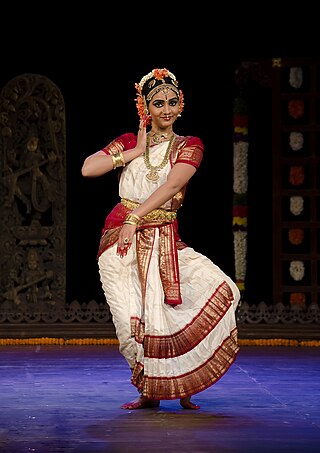
Kuchipudi is one of the eight major Indian classical dances. It originates from a village named Kuchipudi in the Indian state of Andhra Pradesh. Kuchipudi is a dance-drama performance, with its roots in the ancient Hindu Sanskrit text of Natya Shastra. It developed as a religious art linked to traveling bards, temples and spiritual beliefs, like all major classical dances of India.

Indian classical dance, or Shastriya Nritya, is an umbrella term for different regionally-specific Indian classical dance traditions, rooted in predominantly Hindu musical theatre performance, the theory and practice of which can be traced to the Sanskrit text Natya Shastra. The number of Indian classical dance styles ranges from six to eight to twelve, or more, depending on the source and scholar; the main organisation for Indian arts preservation, the Sangeet Natak Academy recognizes eight: Bharatanatyam, Kathak, Kuchipudi, Odissi, Kathakali, Sattriya, Manipuri and Mohiniyattam. Additionally, the Indian Ministry of Culture includes Chhau in its list, recognising nine total styles. Scholars such as Drid Williams add Chhau, Yakshagana and Bhagavata Mela to the list. Each dance tradition originates and comes from a different state and/or region of India; for example, Bharatanatyam is from Tamil Nadu in the south of India, Odissi is from the east coast state of Odisha, and Manipuri is from the northeastern state of Manipur. The music associated with these different dance performances consists many compositions in Hindi, Malayalam, Meitei (Manipuri), Sanskrit, Tamil, Odia, Telugu, and many other Indian-Subcontinent languages; they represent a unity of core ideas, and a diversity of styles, costumes and expression.

Tandava, also known as Tāṇḍava Natyam, is a divine dance performed by Hindu god Shiva. Shiva is depicted as dancing the Tandava in his form of Nataraja.
Alarmel Valli is an Indian classical dancer and Bharatanatyam-Pandanallur choreographer.

Savitha Sastry is an Indian dancer and choreographer best known as an exponent of Bharatanatyam. She is known to experiment with the format of traditional Bharatanatyam by using the techniques of Bharatanatyam to showcase theme-based productions based on novel stories, not based on Indian mythology or religion. Her innovations have been described as 'path breaking' by critics. and she is considered to be a 'renaissance architect' who 'holds the distinction of being the dancer to have brought out a revolution in the way Bharatanatyam is presented after Rukmini Devi Arundale'.
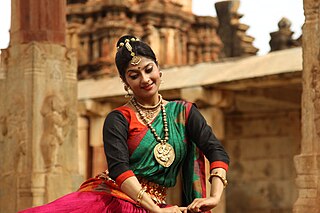
Nirupama Rajendra is a notable Indian classical dancer in the Bharathnatyam and Kathak dance forms. She is based in Bangalore, Karnataka. Nirupama and her husband Rajendra perform Kathak together. They established the Abhinava Dance Company in 1994 with an aim to make dance more accessible. They are known for fusing traditional and contemporary dance styles. The dance duo has given many performances and received several awards including Natya Mayuri and Natya Mayura (1998), Karnataka Kalashree (2011) and Nritya Choodamani.

Parshwanath Upadhye is an Indian classical dancer, choreographer and teacher. He is trained in the traditional Mysore style of Bharatanatyam.
Kalamandalam V. Satyabhama was an Indian classical dancer, teacher and choreographer, known for her performances and scholarship in mohiniyattam. She was awarded the Padma Shri, in 2014, for her contributions to the art and culture, by the Government of India.
Madras Kadiravelu Saroja, known as Puliyur Saroja, was an Indian classical dancer, known for her expertise, as an exponent and as a teacher, in the classical dance form of Bharatanatyam. The Government of India honored her, in 2011, with the Padma Shri, the fourth highest civilian award, for her services to the field of art and culture.
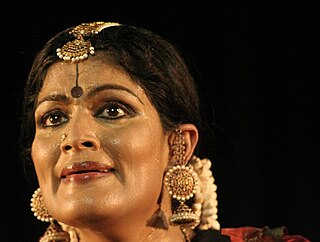
Geeta Chandran is an Indian Bharatanatyam dancer and vocalist. Trained in Carnatic music, she is a visionary and celebrated artist in Indian classical Bharatanatyam, recognized for her work in theatre, dance, education, videos and films.
Meenakshi Chitharanjan, an Indian classical dancer, teacher and choreographer, is known as an exponent of the Pandanallur style of the classical dance form of Bharatanatyam. She is the founder of Kaladiksha, an institution promoting Bharatanatyam and striving to preserve the Pandanallur tradition. A disciple of the father-son duo of Chokkalingam Pillai and Subbaraya Pillai, she is a recipient of several honours including Kalaimamani Award of the Government of Tamil Nadu and the Natya Kala Sarathi of Sri Parthasarathy Swami Sabha. The Government of India awarded her the fourth highest civilian honour of the Padma Shri, in 2008, for her contributions to classical dance.
Vasundhara Doraswamy is the founder and director of Vasundhara Performing Arts Centre, Mysore (India). She is a Bharatanatyam dancer, choreographer, and guru (teacher). She is also one of the disciples of the late Shri Pattabhi Jois in the discipline of Ashtanga Vinyasa Yoga and has developed her own subdomain in Vasundhara Style.
Bhagavata Mela is a classical Indian dance that is performed in Tamil Nadu, particularly the Thanjavur area. It is choreographed as an annual Vaishnavism tradition in Melattur and nearby regions, and celebrated as a dance-drama performance art. The dance art has roots in a historic migration of practitioners of Kuchipudi, another Indian classical dance art, from Andhra Pradesh to the kingdom of Tanjavur.

Ananda Shankar Jayant is an Indian classical dancer, choreographer, scholar and bureaucrat, known for her proficiency in the classical dance forms of Bharatanatyam and Kuchipudi. She is the first woman officer in the Indian Railway Traffic Service on South Central Railway and her 2009 TED talk is ranked among the top twelve Incredible TED talks on cancer. She is a recipient of Sangeet Natak Akademi Award, Kalaimamani Award of the Government of Tamil Nadu and Kala Ratna Award of the Government of Andhra Pradesh. The Government of India awarded her the fourth highest civilian honour of the Padma Shri, in 2007, for her contributions to arts.

Kalaimamani Shri Guru Madurai R. Muralidaran is an acclaimed dance Guru (teacher), composer, dancer, choreographer, lyricist, playwright and director best known for his large body of modern compositions for Bharatanatyam dancers and his many elaborate dance musical productions. His works explore the complexities of Bharathanatyam theory and rhythms while remaining accessible and appealing to a modern lay audience.

Mithun Shyam is an Indian Bharatanatyam dancer, choreographer and teacher based in Bengaluru. He has contributed to social and gender-based themes through classical dance.
Hema Rajagopalan is a Bharatanatyam dancer, teacher and choreographer from New Delhi, India.
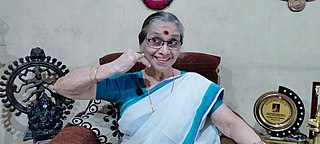
Kala Vijayan is an Indian classical dance performer, choreographer, author and actor. She is the daughter of the legendary Kathakali artist Kalamandalam Krishnan Nair and Mohiniyattam exponent Kalamandalam Kalyanikutty Amma. Kala Vijayan is trained in Mohiniyattam, Bharatanatyam and Kathakali, however she is best known for her contributions to Mohiniyattam. She is the recipient of Kerala Sangeetha Nataka Akademi Award for Mohiniyattam (1998) and the Kerala State Award for Mohiniyattam (2019). She is the Principal Director and senior Guru at Kerala Kalalayam, a fine arts institute established by her parents at Thripunithura in 1952.
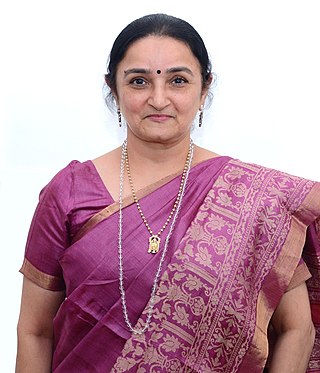
Sandhya Purecha is a senior Bharatanatyam exponent, Author and renowned practitioner of Indian classical dance. She is the first person to bring on stage the performance in Bharatnatyam style of the entire Abhinaya Darpan dance treatise as defined by Nandikeshwara in Abhinaya Darpan and as choreographed by her Guru Parvati Kumar. Purecha has researched on Kalasa Karana and published it in 2010.












